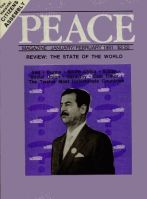
Peace Magazine Jan-Feb 1991, page 25. Some rights reserved.
Search for other articles by Anatol Rapoport here
FROM THE perspective of the affluent and still war-less world, it appears as if a large step toward peace presaged by the end of the ColdWar was offset by the sudden threat posed by the Gulf Crisis. How does it look from the perspective of the Third World, where war has been raging throughout the decades since the end of World War II? In particular, has the transition to the post Cold War era brought any relief?
To get some idea, we will compare levels of violence in 1989 and in 1990 in the "twelve most unfortunate countries in the world." The 1989 estimates compiled by Ruth Leger Sivard (World Military and Social Expenditures) are of both military and civilian deaths. The 1990 estimates, compiled by the Stockholm International Institute of Peace Research (SIPRI)have been only partly segregated. Still, some differences are discernable.
In sum, in 1989, 2,847,000 war-related deaths were estimated in the twelve most unfortunate countries. Of these, 89% were civilians. In 1990, about
1,900,000 war-related deaths were estimated in the same countries. Where the civilian and military deaths were segregated, the former comprised about 83% of the total. The reduction of war-related deaths by about one-third may or may not indicate a trend. On the other hand, the proportion of civilian deaths directly attributed to Third World wars remains appallingly high.
The 1989 human rights record of the "twelve most unfortunate countries in the world" was in some ways the most horrendous in recent history. The following are short excerpts from a report prepared by PIOOM-a Dutch acronym for "Projects for the Interdisciplinary Study of Root Causes of Human Rights Violations" (cf Newsletter Vol. 2, No.2, Auturnn, 1990).
Alghanistan. More than a million people died as a direct consequence of the war during the last decade. Fighting continued after the withdrawal of Soviet troops. Political killings, disappearance, and systematic torture are pervasive.
Sudan. Political killings, disappearance, and systematic torture are commonplace. The major causes of death in areas affected by the civil war were interference or failure of both sides to cooperate with food relief efforts.
Mozambique. The guerrillas deliberately attack economic targets. Reports of widespread massacres directed against civilians, kidnappings, torture, and looting continued throughout 1990.
Uganda. Credible reports ofcivilian casualties, illegal detentions, and torture by the government continued.
Guatemala. In 1989 the country saw a resurgence of violence and terrorism, much of it politically inspired. There were frequent reports ofbrutality by the military.
Ethiopia. The insurgencies made Ethiopia probably the most lethal armed conflict of the year 1989. Torture has been used against members ofsix major and six minor insurgent groups.
El Salvador. A new peak in civilian deaths was reached in 1989. In November, the insurgents launched a nationwide offensive in an attempt to make the country ungovernable. Right wing vigilantism continued to terrorize the population. The security forces have been reported to use both physical and psychological torture. Air Force bombmg near civilian population centres caused civilian deaths. Unmarked and indiscrimately placed landmines and booby traps by guerrillas are a major cause of death and maiming among peasants.
Lebaaon. Six months of virtually continuous artillery exchanges brought about injury and death to thousands of civilians. All participants in the fighting appear to have adopted a deliberate policy of applying pressure for political concessions through intimidation of the civilian population.
Angola. Reports of political killings on the part of People's Revolutionary Arrny forces and UNITA both in combat areas and in the form of summary executions, persisted in 1989. The resumption of conflict in August, 1989, led to some of the most violent fighting.
Peru. As measured by the number of reported deaths, 1989 was the most violent year since "Shining Path" announced its "popular war" in 1980. At least 3,198 persons (civilian and military) were killed in 1989-an increase of over 50% from the previous year. About 500 new cases ofdisappearances were filed in 1989. It is estimated that the government was responsible for a total of 1,228 deaths in 1989.
Sri Lanka. Credible allegations linked thegovemment security forces to extrajudicial killings, disappearance, and torture. The rise of anti-communist vigilante groups in the south was a disturbing development in 1989. Independent estimates put the number ofpolitical killings at over 8,500, including 5,000 civilians.
Iraq. Iraq's human rights record remained abysmal in 1989. An armed Kurdish insurgency continued in 1989.
The government established a depopulated security zone along the full length of Iraq's borders with Iran and Turkey. Under this program the government had destroyed villages within a 30km-wide zone and relocated approximately 50,000 Kurdish and Assyrian inhabitants into more easily controlled towns. Thousands ofpeople who were arrested over the years by Iraqi security or intelligence forces disappeared while in detention, with many feared executed.

Peace Magazine Jan-Feb 1991, page 25. Some rights reserved.
Search for other articles by Anatol Rapoport here